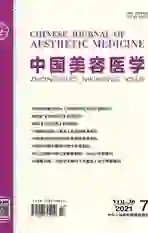唐山地区混合牙列期正常牙合青少年下颌牙弓及双侧第一磨牙三维方向生长发育变化研究
2021-08-19杨大鹏丁士育李培培员丽影
杨大鹏 丁士育 李培培 员丽影
[摘要]目的:探究唐山地區年龄为10岁处于混合牙列期正常牙合青少年下颌牙弓及下颌双侧第一磨牙在三维方向上的生长发育变化。方法:对唐山地区某小学年龄为10岁的正常牙合青少年进行筛选,按照标准筛选出研究样本40例(男20例,女20例)。每年取石膏模型一副,连续跟踪两年,应用3-shape扫描仪扫描石膏模型,将其转化为数字模型。在数字模型上进行牙弓及第一磨牙三维方向上的生长发育变化的研究。结果:过去两年中,下颌前部牙弓长度(LAAL)增加了0.556mm,下颌全部牙弓长度(LTAL)增加了2.067mm,下颌乳尖牙或恒尖牙间牙弓宽度(LICW)增加了2.904mm,下颌第一磨牙间牙弓宽度(LIMW)增加了2.172mm。年龄为12岁的男性LIMW大于女性。右下第一磨牙颊舌向倾斜度(LR6BL)和左下第一磨牙颊舌向倾斜度(LL6BL)分别增加了2.841°和5.410°。结论:10~12岁正常牙合青少年的下颌前部牙弓长度(LAAL)、下颌全部牙弓长度(LTAL)、下颌乳尖牙或恒尖牙间牙弓宽度(LICW)、下颌第一磨牙间牙弓宽度(LIMW)均随年龄增长而增加。年龄为12岁的男性第一磨牙间牙弓宽度均大于女性。下颌双侧第一磨牙随年龄的增加呈颊向倾斜,而近远中向倾斜度无明显变化。年龄为12岁的男女下颌第一磨牙的近远中和颊舌向倾斜度无性别差异。
[关键词]正常牙合;下颌牙弓宽度;下牙弓长度;下颌第一磨牙颊舌向倾斜度;下颌第一磨牙近远中向倾斜度;混合牙列期;3D数字模型
[中图分类号]R78 [文献标志码]A [文章编号]1008-6455(2021)07-0098-05
Study on Three-dimensional Growth and Development of Mixed Dentition Lower Dental Arch and Bilateral First Molar of Teenagers with Normal Occlusion in Tangshan City
YANG Da-peng1,DING Shi-yu2,LI Pei-pei1,YUN Li-ying1
(1.Department of Orthodontics,Tangshan Union Medical college Hospital,Tangshan 063000,Hebei,China;2.Department of Stomatology,Tangshan Vocational & Technical College,Tangshan 063000,Hebei,China)
Abstract: Objective The purpose of this study was to observe the three-dimensional growth and development of the mandibular dental arch and bilateral lower first molar in 10-year-olds with normal occlusion during the mixed dentition stage in Tangshan. Methods Forty-10-year-old students (20 males and 20 females) who had normal occlusion during mixed dentition were selected from an elementary school in Tangshan, China. Once per year for two consecutive years, a dental cast was obtained from each subject, and the cast was scanned with a 3D digital scanner. The three-dimensional measurements of the mandibular dental arch were obtained from the digital model. Results The lower anterior arch length (LAAL) increased 0.556mm, lower total arch length (LTAL) increased 2.067mm, lower inter primary or permanent canine width (LICW) increased 2.904mm and lower intermolar width (LIMW) increased 2.172mm over the two years. The buccolingual inclination of the lower right first molar (LR6BL) and left first molar (LL6BL) were increased by 2.841° and 5.410°. Conclusion The lower anterior mandibular arch (LAAL), the lower total arch length(LTAL), the lower inter primary or permanent canine width (LICW), and the lower intermolar width (LIMW) in 10- to 12-year-olds with normal occlusion increased with age. The LIMW were larger in males than in females at 12 years old. The lower bilateral first molar showed buccal inclination with age, but the mesiodistal inclination did not changed significantly. There is no gender difference in the mesiodistal and buccolingual inclination of the lower first molars at 12 years old.
Key words: normal occlusion; lower arch width; lower arch length; lower first molars buccal-lingual inclination; lower first molars mesiodistal inclination; mixed dentition stage; 3D digital model
下前牙在混合牙列阶段的轻度拥挤被认为是一个极为常见的现象。此问题通常通过以下两种方法解决:下颌尖齿间牙弓宽度略微增加,使得下颌侧切牙相对于下颌中切齿唇侧移动,或者下颌尖牙利用灵长间隙轻微向远中移动。据估计,从下颌中切牙开始萌出到下颌尖牙萌出,此阶段下切牙的拥挤度平均减小约0.9mm[1]。当拥挤程度更大时,可能无法通过正常的牙弓发育进行矫正,需要早期干预或者减数拔牙从而解决拥挤问题。一项研究表明,大约90%的儿童在混合型牙列早期出现拥挤,而在恒牙列中仍然表现为拥挤,而自行矫正的儿童在混合牙列早期只有0.5mm的拥挤度[2]。
导致牙列拥挤的因素很多,例如牙弓长度的减小,牙弓宽度的减小以及过大牙的存在。在一项研究中发现有拥挤的受试者和没有拥挤的受试者之间的弓形尺寸存在显著差异[3]。一项研究报告显示,上下颌牙弓长度以及乳尖牙的近远中宽度都是可能导致中切牙拥挤的重要因素[4]。另一项研究结果发现,下颌中切牙的近远中宽度越大,拥挤度就越大[5]。
关于青少年牙弓生长发育的变化,国内外学者已经进行了大量的研究,并提出了不同甚至相反的结论,特别是在混合牙列末期和恒牙列初期。所以混合牙列末期既是青少年牙弓生长发育变化的重要阶段,也是导致下前牙发生拥挤的关健阶段。弄清此阶段牙弓生长发育的变化将有助于区分那些因牙列拥挤需要正畸治疗的患者和那些可能自我纠正的患者。Ahn JS[6]对一组6岁儿童进行了一项连续9年随访研究,发现未经治疗的儿童尖牙间牙弓宽度随年龄的变化而减少。但Slaj M[7]对比8~12岁处于混合牙列初期儿童与10~14岁处于混合牙列末期儿童的牙弓,发现尖牙间牙弓宽度没有发生显著变化。所以对于牙弓的纵向研究很有意义,因为其能够提供有关牙列生长发育的不同阶段以及牙列拥挤如何发展的信息。
1 资料和方法
1.1 临床资料:本研究样本为唐山市某小学学生,选择年龄为10岁处于替牙末期,恒牙初期的正常牙合青少年。
1.2 入选标准:①安氏Ⅰ类磨牙关系;②面部轮廓对称,无明显面部畸形,面部轮廓无突出或后缩;③无畸形牙或缺失牙;④无牙齿矫正治疗史;⑤无反咬合;⑥无面部外伤史或身体状况异常。最终获得研究样本40例(其中男20例,女20例)。
1.3 研究方法:给每位正常牙合青少年每年取石膏模型一副,连续两年,每人获得石膏模型共3副,共获得石膏模型120副。应用石膏模型修整机对石膏模型进行模型制备,并将其修整成为标准模型。将120副标准石膏模型应用三维数字激光扫描仪(R700 3D Dental Scanner,3-Shape A/S,Copenhagen,Denmark)扫描完成后,将石膏模型转化成三维数字模型。在数字模型上进行标志点和参考平面及测量项目的定义。
下颌牙弓长度包括下颌前部牙弓長度(LAAL)和下颌全部牙弓长度(LTAL)。下颌牙弓宽度包括下颌乳尖牙或恒尖牙间牙弓宽度(LICW)和下颌第一磨牙间牙弓宽度(LIMW)。这些线距的标志点定义及测量见图1,下颌牙弓周长(LDAL)见图2。在二维空间中,角是由两条线构成的。而在三维空间中,角是由两个平面构建的。构成下颌第一磨牙颊舌向倾斜度及近远向倾斜度的标志点,参考平面见图3~4。
1.4 统计学分析:所有数据分析均使用SPSS 22.0(SPSS,Chicago,Ⅲ)版本进行,每个受试者提供线性和角度测量的多次重复观察。随机选择20个样本并由同一检验者重新测量以计算方法误差。通过计算每个线距和角度测量的组内相关系数和测量误差来评估检查者测量的重复性,使用配对t检验比较每个连续变量之间的平均差异,两次测量之间没有显著差异。用于计算年龄变化的描述性统计数据,包括均值和标准差。用Kolmogorov-Smirnov测试数据的正态分布。将非正态分布数据与弗里德曼的非参数统计数据进行比较,并将重复测量数据用于正态分布数据。P<0.05认为差异具有统计学意义。
2 结果
2.1 不同年龄下颌牙弓测量项目变化情况:下颌牙弓测量项目过去两年中不同年龄变化结果见表2和图5。过去两年中LAAL,LTAL,LICW,LIMW的平均值分别增加了0.556mm,2.067mm,2.904mm,2.172mm,其差值具有统计学意义差异具有统计学意义(P<0.05);其余下颌测量项目在过去两年中的变化无统计学意义。
2.2 不同性别下颌牙弓测量项目变化情况:下颌牙弓测量项目过去两年中不同性别比较结果见表3和图6,所有测量项目在过去两年中的变化均无性别差异。
2.3 不同性别12岁青少年下颌牙弓测量项目比较:12岁青少年下颌牙弓测量项目不同性别比较结果见表4和图7。男性LIMW均值比女性大2.339mm,且差异具有统计学意义(P<0.05),其他指标比较差异无统计学意义。
2.4 不同年龄下颌双侧第一磨牙颊舌向和近远中向倾斜度比较:不同年龄LR6BL的平均角度分别为37.776。、39.885。、40.617。,LL6BL的平均角度分别为37.100。、39.770。、42.510。,过去两年中LR6BL和LL6BL的角度分别增加了2.841。和5.410。。随着年龄的增长冠颊舌向倾斜度为逐渐增大的趋势。不同年龄LR6MD的平均角度分别为72.209。、71.981。、71.196。,LL6MD的平均角度分别71.405。、71.993。、72.677。,双侧下颌第一磨牙近远中倾斜度随年龄增长而无明显变化。
2.5 不同性别12岁青少年下颌第一磨牙的近远中和颊舌向倾斜度比较:不同性别12岁青少年下颌第一磨牙的近远中和颊舌向倾斜度比较差异无统计学意义。见表6,图9。
3 讨论
3.1 下颌尖牙及磨牙间牙弓宽度:一些学者的研究发现在恒尖牙萌出过程中,尖牙间牙弓宽度持续增大直到恒尖牙萌出完成[8-10]。还有研究发现尖牙间牙弓宽度持续性增加到10岁,但16~31岁,尖牙间牙弓宽度呈持续性下降[11]。尖牙间牙弓宽度增加最可能的原因是在下颌中切牙萌出期间,有一个侧向力施加在相邻侧切牙上,该侧向力将侧切牙推向恒尖齿,使得尖牙间牙弓宽度增大[12]。同样,侧切牙的萌出同样会使尖牙间的牙弓宽度增大。本次研究结果发现10~12岁,尖牙间牙弓宽度增加约0.9mm,差异有统计学意义,这与以上研究结果相同。所以一些发生在儿童前牙区的轻微拥挤将因为尖牙间牙弓宽度的增加,可能不需要治疗,只需要在恒牙萌出过程中进行观察即可[4]。有学者对54名瑞典儿童在年龄分别为7岁、9岁、10岁和14岁时进行尖牙间牙弓宽度的测量,并得出结论:当尖牙间牙弓宽度小于26mm时,发生前牙拥挤的机率非常高。而当尖牙间牙弓宽度大于28mm时,发生前牙拥挤的机率几乎为零[13]。还有学者研究发现9~10岁,也就是恒尖牙萌出过程中,前牙发生拥挤,而当12~14岁,前牙拥挤度下降,当14~18岁拥挤度又有所上升[14]。
本次研究中发现10~12岁,磨牙间牙弓宽度也是随年龄的增大而增大,且差异有统计学意义,这与Alvaran N[15]和Arslan SG[16]的研究结果相一致。
3.2 下颌尖牙及磨牙间牙弓长度:本研究对象年龄为10岁的正常牙合青少年下颌牙弓进行了连续2年的观察,下颌前部牙弓长度和下颌全部牙弓长度均随年龄的增大而增大。LAAL和LTAL在12岁时没有性别差异,这一结果与Okori H[17]的结果相一致。而一些研究结果发现牙弓长度随年龄的增加而减少[18-19]。而本研究结果发现前部牙弓长度和全部牙弓长度随年龄的增大而呈增大的趋势。这些相反的结论与样本的选择、样本量的大小以及测量时标志点位置的不同有关。
3.3 下颌双侧第一磨牙颊舌向及近远中向倾斜度:Sayania B[20]纵向研究上下颌第一磨牙的颊舌向倾斜度,并显示下颌第一磨牙在萌出时腭向倾斜,随着年龄的增长而呈颊向倾斜的趋势。Yang B[21]比较了未经治疗的成年人和儿童磨牙颊舌向倾斜度,结论为下颌第一磨牙表现出颊向倾斜的趋势,并且青少年的磨牙颊向倾斜度小于成年人。本研究发现下颌双侧第一磨牙的颊舌向倾斜度与以上研究结果相一致,并且发现下颌双侧第一磨牙的近远中向倾斜度并未随年龄的增长而发生明显变化。
在混合牙列期间,年龄10岁的正常牙合青少年连续跟踪两年,其下颌前部牙弓长度(LAAL),下颌全部牙弓长度(LTAL),下颌乳尖牙或恒尖牙间牙弓宽度(LICW),下颌第一磨牙间牙弓寬度(LIMW)均随年龄的增长而增加。12岁时男性下颌第一磨牙间牙弓宽度(LIMW)均大于女性。下颌双侧第一磨牙随年龄的增加呈颊向倾斜,而近远中向倾斜度无明显变化。12岁时男女下颌第一磨牙的近远中和颊舌向倾斜度无性别差异。
[参考文献]
[1]Lundy HJ,Richardson ME.Developmental changes in alignment of the lower labial segment[J].Br J Orthod,1995,22(4):339-345.
[2]Shahid F,Alam MK,Khamis MF.New prediction equations for the estimation of maxillary mandibular canine and premolar widths from mandibular incisors and mandibular first permanent molar widths: A digital model study[J].Korean J Orthod,2016,46(3):171-179.
[3]Zigante M,Pavlic A,Vandevska Radunovic V,et al.Changes of mandibular dental arch shape during adolescence and its influence on late mandibular incisor crowding[J].Homo,2019,70(3):185-192.
[4]Melo L,Ono Y,Takagi Y.Indicators of mandibular dental crowding in the mixed dentition Changes of mandibular dental arch shape during adolescence and its influence on late mandibular incisor crowding[J].Pediatr Dent,2001,23(2):118-122.
[5]Yitschaky O,Neuhof MS,Yitschaky M,et al.Relationship between dental crowding and mandibular incisor proclination during orthodontic treatment without extraction of permanent mandibular teeth[J].Angle Orthod,2016,86(5):727-733.
[6]Ahn JS,Park MS,Cha HS,et al.Three-dimensional interpretation of intercanine width change in children: a 9-year longitudinal study[J].Am J Orthod Dentofacial Orthop,2012,142(3):323-332.
[7]Slaj M,Jezina MA,Lauc T,et al.Longitudinal dental arch changes in the mixed dentition[J].Angle Orthod,2003,73(5):509-514.
[8]Ghaderi F,Momeni Danaei S,Rajaei Y,et al.Prediction of dental arch width increase in the early mixed dentition using craniofacial parameters[J].Minerva Stomatol,2018,67(6):231-236.
[9]Herzog C,Konstantonis D,Konstantoni N,et al.Arch-width changes in extraction vs nonextraction treatments in matched Class Ⅰ borderline malocclusions[J].Am J Orthod Dentofacial Orthop,2017,151(4):735-743.
[10]Oz AA,Oz AZ,Yaziciooglu S,et al.Comparison of arch width changes following orthodontic treatment with and without extraction using three-dimensional models[J].Niger J Clin Pract,2017,20(5):581-586.
[11]Thilander B.Dentoalveolar development in subjects with normal occlusion. A longitudinal study between the ages of 5 and 31 years[J].Eur J Orthod,2009,31(2):109-120.
[12]Kumar N,Jhingta P,Negi KS,et al.Combined periodontal-orthodontic treatment of pathologic tooth migration: a case study with 10-year follow-up[J].Contemp Clin Dent,2018,9(Suppl 2):S377-S381.
[13]Hagberg C.The alignment of permanent mandibular incisors in children. A longitudinal prospective study[J].Eur J Orthod,1994,16(2):121-129.
[14]Aljabaa AH,Alqahtani ND,Aldrees AM,et al.Changes in the mandibular dental arch during the late mixed dentition stage: Experimental study[J].J Pak Med Assoc,2019,69(1):77-81.
[15]Alvaran N,Roldan SI,Buschang PH.Maxillary and mandibular arch widths of Colombians[J].Am J Orthod Dentofacial Orthop,2009,135(5):649-656.
[16]Arslan SG,Kama JD,Sahin S,et al.Longitudinal changes in dental arches from mixed to permanent dentition in a Turkish population[J].Am J Orthod Dentofacial Orthop,2007,132(5):576.e15-21.
[17]Okori H,Apolot PS,Mwaka E,et al.A secondary analysis to determine variations of dental arch measurements with age and gender among Ugandans[J].BMC Res Notes,2015,8:428.
[18]Barros SE,Chiqueto K,Janson G,et al.Effect of Class Ⅱ camouflage treatment on anterior arch length ratio and canine relationship[J].Am J Orthod Dentofacial Orthop,2021,159(1):e7-e16.
[19]Bishara SE,Jakobsen JR,Treder JE,et al.Changes in the maxillary and mandibular tooth size-arch length relationship from early adolescence to early adulthood. A longitudinal study[J].Am J Orthod Dentofacial Orthop,1989,95(1):46-59.
[20]Sayania B,Merchant M,Josephs P,et al.Changes in the buccolingual inclination of first molars with growth in untreated subjects: A longitudinal study[J].Angle Orthod,2017,87(5):681-687.
[21]Yang B,Chung CH.Buccolingual inclination of molars in untreated children and adults: A cone beam computed tomography study[J].Angle Orthod,2019,89(1):87-92.
[收稿日期]2020-12-10
本文引用格式:楊大鹏,丁士育,李培培,等.唐山地区混合牙列期正常牙合青少年下颌牙弓及双侧第一磨牙三维方向生长发育变化研究[J].中国美容医学,2021,30(7):98-102.
